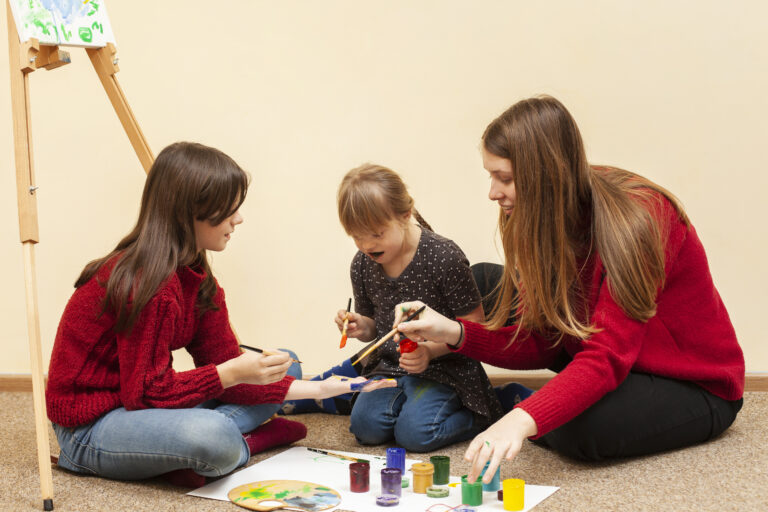How Creative Expression Benefits Children with Autism
For children with autism spectrum disorder (ASD), the world can often feel overwhelming and difficult to navigate. Communication challenges, sensory sensitivities, and social difficulties are common hurdles they face daily. However, creative expression through art, music, dance, and other artistic outlets has emerged as a powerful tool to help these children overcome barriers and thrive. In this comprehensive guide, we’ll explore how various forms of creative expression can benefit children with autism, enhancing their communication skills, emotional expression, and social engagement.
The Power of Art for Autism
Art therapy has shown remarkable potential in supporting children with autism. Through visual arts like painting, drawing, and sculpting, children on the spectrum can find new ways to express themselves and interact with the world around them.
Enhancing Communication
One of the most significant benefits of art for children with autism is its ability to facilitate communication. Many children with ASD struggle with verbal expression, but art provides a non-verbal avenue for conveying thoughts, emotions, and experiences. Through colors, shapes, and textures, children can communicate complex ideas and feelings that they might find challenging to express through words alone.
Art becomes a universal language, allowing children to bridge the gap between their inner world and the external environment. For instance, a child who has difficulty describing their emotions verbally might use bold red strokes in a painting to express anger or soft blue hues to convey calmness. This visual communication can help parents, therapists, and educators better understand the child’s emotional state and needs.
Sensory Exploration and Integration
Many children with autism experience sensory processing differences, which can make certain textures, sounds, or visual stimuli overwhelming or unpleasant. Art therapy offers a controlled environment for sensory exploration, allowing children to engage with various materials at their own pace.
Working with different art mediums – from smooth clay to rough-textured papers – can help desensitize children to different tactile experiences. This sensory integration through art can have far-reaching effects, potentially improving a child’s ability to tolerate and engage with diverse sensory inputs in daily life.
Fostering Emotional Expression
Emotional regulation can be challenging for children with autism, who may struggle to identify and express their feelings appropriately. Art provides a safe outlet for emotional expression, allowing children to process and communicate their emotions in a tangible form.
Through art, children can externalize their internal experiences, making abstract emotions more concrete and manageable. This process can lead to improved emotional awareness and regulation over time. For example, a child might learn to recognize and express feelings of frustration through specific colors or patterns in their artwork, gradually developing a more nuanced understanding of their emotional landscape.
Boosting Self-Esteem and Confidence
Engaging in artistic activities can significantly boost self-esteem and confidence in children with autism. The process of creating something tangible – be it a painting, a sculpture, or a drawing – provides a sense of accomplishment and pride. This positive reinforcement can be especially valuable for children who may struggle in other areas of their lives.
Moreover, art allows for self-expression without the pressure of “right” or “wrong” answers, fostering a sense of autonomy and self-acceptance. As children see their ideas take shape through their creations, they develop a stronger sense of self and personal identity.
Music: A Rhythmic Path to Connection
Music therapy has shown remarkable benefits for children with autism, offering a structured yet flexible medium for expression and interaction.
Improving Social Skills
Music naturally encourages social interaction and engagement. Group music activities, such as singing together or playing instruments in an ensemble, provide opportunities for children with autism to practice turn-taking, listening, and cooperating with others. These skills can then translate to other social situations in their daily lives.
The predictable patterns in music also offer a comforting structure for children who may find social interactions challenging. Through musical games and activities, children can learn to read social cues, respond to others, and engage in reciprocal interactions in a low-pressure environment.
Enhancing Communication Skills
Music therapy can significantly improve both verbal and non-verbal communication skills in children with autism. Singing along to songs can help develop language skills, improve articulation, and expand vocabulary. For non-verbal children, music offers an alternative form of expression, allowing them to communicate through rhythm, melody, and musical choices.
Moreover, the rhythmic components of music can help children with autism develop better timing and pacing in their speech and interactions. This improved sense of timing can lead to more natural-sounding speech patterns and better conversational skills.
Emotional Regulation through Rhythm
The structured nature of music can have a calming effect on children with autism, helping them regulate their emotions and behavior. Rhythmic activities, such as drumming or moving to a beat, can provide a sense of predictability and control, which can be particularly soothing for children who feel overwhelmed by their environment.
Music can also be used as a tool for emotional expression and processing. Different types of music can evoke and help children explore various emotions in a safe, controlled manner. Over time, this can lead to improved emotional awareness and regulation.
Cognitive Skills Development
Engaging with music can enhance various cognitive skills in children with autism. Learning to play an instrument, for instance, can improve fine motor skills, hand-eye coordination, and concentration. Music activities that involve following instructions or remembering sequences can boost memory and executive functioning skills.
Furthermore, the abstract nature of music can help children develop their ability to think symbolically and creatively, skills that can transfer to other areas of learning and problem-solving.
Dance and Movement: Expressing Through the Body
Dance and movement therapy offers unique benefits for children with autism, addressing physical, emotional, and social aspects of development.
Body Awareness and Motor Skills
Many children with autism struggle with body awareness and motor coordination. Dance and movement activities can significantly improve these areas, helping children develop a better sense of their body in space (proprioception) and enhancing their gross and fine motor skills.
Through structured movement exercises and free-form dance, children can improve their balance, coordination, and overall physical fitness. These improvements can have positive effects on their daily functioning, from better posture to more fluid movements in everyday activities.
Non-Verbal Communication Skills
Dance provides an excellent medium for developing non-verbal communication skills. Children with autism can learn to express themselves through body language, gestures, and facial expressions – crucial components of social interaction that they might find challenging to understand or use in typical settings.
By engaging in mirroring exercises or partner dances, children can practice reading and responding to others’ non-verbal cues in a structured, supportive environment. These skills can then generalize to their social interactions outside of dance sessions.
Emotional Expression and Regulation
Movement offers a powerful outlet for emotional expression, allowing children to physically embody and release their feelings. This can be particularly beneficial for children with autism who may struggle to verbalize or process their emotions.
Dance therapy can also teach children strategies for self-regulation through movement. Simple techniques like deep breathing combined with gentle movements can become valuable tools for managing anxiety or overstimulation in daily life.
Social Engagement and Cooperation
Group dance activities provide natural opportunities for social interaction and cooperation. Children learn to move in sync with others, respect personal space, and work together to create choreographed sequences. These experiences can foster a sense of belonging and improve social skills in a fun, low-pressure environment.
Drama and Theater: Stepping into New Roles
Drama therapy and theater activities offer unique benefits for children with autism, particularly in the realms of social understanding and flexible thinking.
Developing Social Understanding
Role-playing and character work in drama activities can help children with autism better understand social situations and perspectives. By stepping into different characters’ shoes, children can explore various social roles and scenarios in a safe, structured environment.
This experiential learning can enhance their ability to recognize and interpret social cues, understand others’ emotions, and develop empathy – skills that are often challenging for individuals with autism.
Improving Flexibility and Adaptability
Theater games and improvisation exercises can help children with autism develop greater cognitive flexibility and adaptability. These activities often require quick thinking and adjusting to unexpected situations, skills that can be particularly beneficial for children who tend to prefer routine and predictability.
Over time, this increased flexibility can translate to better coping skills in real-life situations, helping children adapt more easily to changes in their environment or daily routines.
Enhancing Verbal and Non-Verbal Communication
Drama activities provide ample opportunities for practicing both verbal and non-verbal communication. Through scripted dialogues and improvised scenes, children can work on their speech clarity, intonation, and conversational skills.
Equally important, drama emphasizes the use of body language, facial expressions, and gestures to convey meaning. This focus on non-verbal communication can help children with autism become more aware of and proficient in using these crucial aspects of social interaction.
Building Confidence and Self-Expression
Participating in drama activities and performances can significantly boost confidence and self-esteem in children with autism. As they master new skills and receive positive feedback, children often develop a stronger sense of self-efficacy and pride in their abilities.
Moreover, drama provides a structured yet creative outlet for self-expression, allowing children to explore and communicate their thoughts and feelings in new ways.
Integrating Creative Expression into Daily Life
Promoting Life Skills for Children with Special Needs goes beyond structured lessons—it can be integrated into everyday activities. While formal therapy sessions can be incredibly beneficial, incorporating creative expression into daily life can amplify these benefits for children with autism, helping them develop communication, social, and problem-solving skills in an engaging and meaningful way.
Creating a Supportive Environment at Home
Parents and caregivers can foster creativity at home by setting up dedicated spaces for artistic activities. This might include an art corner with various materials, a music area with simple instruments, or a space for movement and dance. The key is to make these creative outlets easily accessible and inviting.
Encouraging Regular Creative Time
Setting aside regular time for creative activities can help children with autism develop a consistent outlet for expression and skill development. This doesn’t have to be structured or formal – even 15 minutes of free drawing or dancing to music each day can be beneficial.
Celebrating and Sharing Creations
Showing genuine interest in and appreciation for a child’s creative efforts can significantly boost their confidence and motivation. Display artwork, record musical performances, or organize small “shows” for family members to celebrate the child’s creative expressions.
Incorporating Creativity into Learning
Creative approaches can be integrated into other areas of learning and daily routines. For instance, using songs to teach new concepts, incorporating movement breaks during study time, or using art projects to explore academic subjects can make learning more engaging and accessible for children with autism.
Conclusion: A World of Possibilities Through Creativity
Creative expression offers a world of possibilities for children with autism. Through art, music, dance, drama, and other creative outlets, these children can find new ways to communicate, express emotions, engage socially, and develop crucial skills for navigating the world around them.
The benefits of creative expression extend far beyond the immediate joy of creation. They touch on core areas of development, from communication and social skills to emotional regulation and cognitive flexibility. For many children with autism, creative activities provide a bridge between their inner world and the external environment, offering pathways to connection and understanding that might otherwise remain closed.
As parents, educators, and therapists, embracing and encouraging creative expression can open up new avenues for supporting children with autism. Enrolling a child in a school for autism can provide specialized programs that nurture their strengths and foster artistic exploration in a supportive environment. By providing opportunities for creative expression and valuing the unique perspectives that emerge, we can help these children unlock their potential and find their voice in the world.
At It’s a Sensory World, we believe in the transformative power of creative expression for children with autism. We encourage families to explore various creative outlets, find what resonates with their child, and incorporate these activities into daily life. Remember, every brush stroke, musical note, dance move, or dramatic performance is a step towards greater understanding, expression, and connection for children on the autism spectrum.



